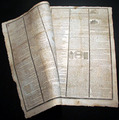Home >
The desired "tombstone edition" published the day before the Stamp Act took effect...
The desired "tombstone edition" published the day before the Stamp Act took effect...
Item # 716222
Currently Unavailable. Contact us if you would like to be placed on a want list or to be notified if a similar item is available.
October 31, 1765
THE PENNSYLVANIA JOURNAL & WEEKLY ADVERTISER, Philadelphia, October 31, 1765 We are pleased to offer one of the most desirable issues of the collecting hobby.
Its desirability is self-evident. It is extremely rare (we are aware of two issues offered in the last 40+ years), it offers a very bold & graphic statement, and has considerable historical significance due to its protest against the British Stamp Act set to take effect the following day.
This particular edition, famously known as the "tombstone edition," used striking visual and textual elements to express colonial outrage over the tax, which required many printed materials, including newspapers, to bear a revenue stamp. This tax directly impacted printers and publishers, placing a heavy economic burden on them and fueling widespread resistance.
Its desirability is self-evident. It is extremely rare (we are aware of two issues offered in the last 40+ years), it offers a very bold & graphic statement, and has considerable historical significance due to its protest against the British Stamp Act set to take effect the following day.
This particular edition, famously known as the "tombstone edition," used striking visual and textual elements to express colonial outrage over the tax, which required many printed materials, including newspapers, to bear a revenue stamp. This tax directly impacted printers and publishers, placing a heavy economic burden on them and fueling widespread resistance.
As seen in the photos, the masthead featured a skull and crossbones, a powerful symbol representing the "death" of the press under the weight of the Stamp Act. Also, an engraving of a coffin appears at the bottom of the back page captioned: "The last Remains of the PENNSYLVANIA JOURNAL Which departed this Life, the 31st of October, 1765, Of a Stamp in her Vitals, Aged 23 Years."
Publisher William Bradford begins the issue with poignant commentary, including: "I am sorry to be obliged to acquaint my readers, that as The Stamp Act is fear'd to be obligatory upon us after the First of November ensuing (the fatal to-morrow) the publisher of this paper unable to bear the burthen, has thought it expedient to stop a while, in order to deliberate whether any methods can be found to elude the chains forged for us..." with more.
Published just one day before the Stamp Act’s enforcement, this edition cleverly voiced dissent without yet violating the law, making it a strategic act of defiance.
Published just one day before the Stamp Act’s enforcement, this edition cleverly voiced dissent without yet violating the law, making it a strategic act of defiance.
This "tombstone edition" of the Pennsylvania Journal captured this economic strain and transformed it into a public rallying cry.
This edition stands as a vivid example of how the colonial press used creativity to oppose British policies, contributing to the growing revolutionary sentiment. It underscores the critical role newspapers played in shaping public opinion and mobilizing opposition in the years leading up to the American Revolution.
While other newspapers also protested the Stamp Act, the Pennsylvania Journal’s dramatic tombstone imagery made it particularly memorable and influential. It galvanized public resistance, cementing its place as a powerful symbol of defiance in American history.
Complete in four pages, never bound nor trimmed, it measures 10 1/4 by 15 3/4 inches. This issue has had some professional restoration work. Scattered foxing or light staining throughout, causing no loss of readability. Mild rubbing at some folds, again without loss of text or readability.
While other newspapers also protested the Stamp Act, the Pennsylvania Journal’s dramatic tombstone imagery made it particularly memorable and influential. It galvanized public resistance, cementing its place as a powerful symbol of defiance in American history.
Complete in four pages, never bound nor trimmed, it measures 10 1/4 by 15 3/4 inches. This issue has had some professional restoration work. Scattered foxing or light staining throughout, causing no loss of readability. Mild rubbing at some folds, again without loss of text or readability.
Category: The 1600's and 1700's






























